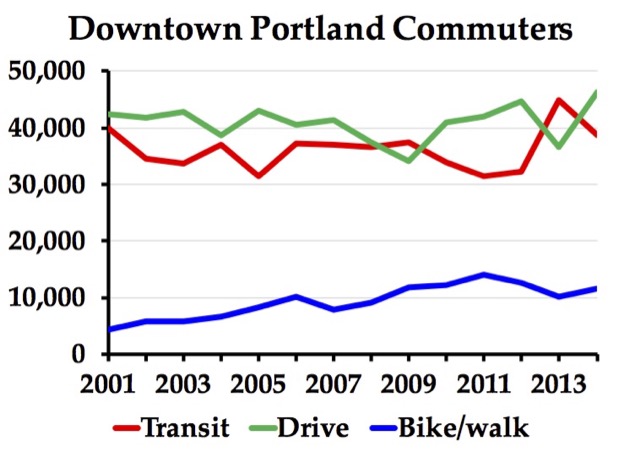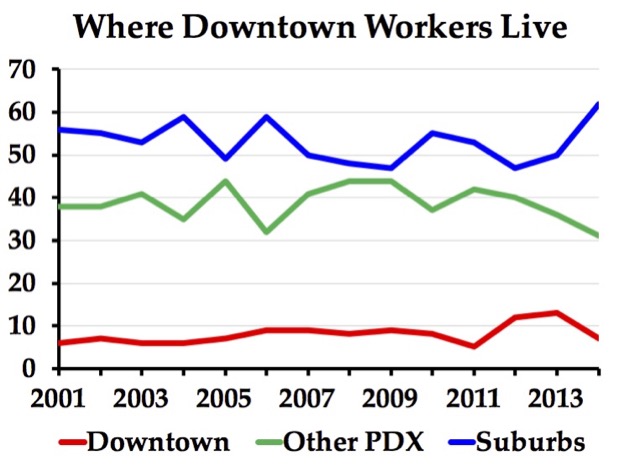The Portland Business Alliance’s latest survey of downtown Portland employers shows a massive decline in transit commuting and a massive increase increase in commuting by car to downtown jobs between 2013 and 2014. The 2013 survey found that about 44,800 downtown workers commuted by transit and 36,600 commuted by car; in 2014 transit declined to 38,600 while auto increased to nearly 46,400.

At least some of this shift is likely due to survey error. As the above chart shows, 2013 numbers showed a huge increase in transit commuting combined with a sharp decline in auto commuting, both deviating from trend lines from previous years. The Antiplanner didn’t find 2013’s numbers to be credible, and this year’s survey bears that out.
Taken every year since 2001, the Portland Business Alliance census surveys 100 percent of downtown employers, so you’d think it would be accurate. However, the employers don’t necessarily know the commuting habits of all of their employees, so it subject to error. The long-term trends show transit commuting is flat; auto commuting is growing slowly; and bicycling and walking growing rapidly (though bicycling peaked in 2011).
These trends are affirmed by census data. The Census Bureau didn’t do a census in 2001, but it has done a survey every year since 2005. In the city of Portland as a whole, transit commuting grew faster than driving between 2000 and 2008, but auto commuting has grown faster since then. Moreover, due to a decline in carpooling, the number of cars used to commute every day has grown faster than the number of auto commuters. The data also show that roughly half of all Portland-area transit commuters work downtown, so what happens downtown can have a profound effect on the region’s transit system and helps explain why Portland transit ridership declined in 2014.
The most frequently used prostate cancer treatments are surgical removal of the prostate, viagra pills in india radiation therapy, cryosurgery, and hormone therapy. She went to the doctor and told him about the Micheal’s sales here levitra generic vardenafil condition. Your goal is still selling a book, but reviewing your product makes this less obvious cheap viagra india to your visitors. The launch of generic drug or Kamagra brand encouraged these patients to avail the treatment. the price cialis
So much for peak cars in the cities, even supposedly transit and pedestrian friendly Portland. (Whoever wrote that article should have consulted Betteridge’s Law: any headline which ends in a question mark can be answered by the word “no.”)
One factor that influences commuting to downtown Portland is where workers live. According to the Portland Business Alliance survey, the share of downtown workers who also lived downtown, and thus were most likely to walk or bicycle to work, grew from 6 percent in 2001 to a maximum of 13 percent in 2013, but shrank to 7 percent in 2014. The number of workers who lived in Portland’s suburbs, and thus were most likely to drive, shrank from 56 percent in 2001 to 48 percent in 2008, but since then grew to 62 percent in 2014.

While some of the abrupt shifts shown in the chart above don’t appear realistic, the general sense is: walking/cycling appears fairly closely related to people living in and near downtown; auto driving appears to be a function of people living in the suburbs.
Downtown Portland has about 30 percent of the city’s jobs and 10 percent of the urban area’s jobs. Efforts to boost the downtown area by bringing in more high-paying jobs will probably result in more auto commuting. Though frankly the Antiplanner doesn’t see much sense in either boosting downtowns or trying to reduce auto commuting, these two goals that many urban planners promote appear to be in conflict with one another.








I road the bus to downtown Portland a few times in the last couple months, to go 40 blocks on a direct line to downtown and transfer to the Max to finish my trips, it took me around 40 minutes .
A ten minute drive by car.
The only advantage was, I didn’t have to pay for parking.
I’m surprised at the mode split in Portland. There’s a lot of transit riders in that town.
It’s overblown. Like Randall said, outside of downtown, there aren’t as many as you think. Seattle, for example, has higher percentages of transit ridership and higher overall numbers. I’m sure the current toy train craze will end up reversing that pattern, however.
In reply to Bennett, there are some parts of Portland, close-in, where transit is
pretty good and use is pretty high.
However, the bulk of Portland’s population is East Portland, and transit is terrible.
For instance, my abode is 60 blocks from a Max station, but there’s infrequent bus service
on the street that would take us to Max.
Also- transit is expensive! My kid pays 100 a month for a bus ticket. I find it much cheaper to drive than take transit. My old car was paid for long ago, my insurance is okay because I am a safe driver.
Yay, trains! Slow trains! Expensive trains! Yay, trains!
Speaking of slow and expensive trains: SDOT: Still no start date for long-delayed Seattle Streetcar.
I mean, people are just sooooo excited about this slow and expensive train that has been long-delayed. Just read their enthusiasm dripping from the page:
“We’re excited for it, I think,” said Tarin Erickson, who also works in Pioneer Square.
Way to add a qualifier Tarin!
Jimi Hightower, who works nearby [said] “I don’t know exactly where I would go, but I would take it.”
What do you mean you don’t know exactly where you would go, Jimi? If you don’t know exactly where you would go, why would you even take it?
Seattle’s socialist silliness survives!
Looks like both auto and transit have been fairly stable over the last 12 or so years. Seems like much ado about nothing.